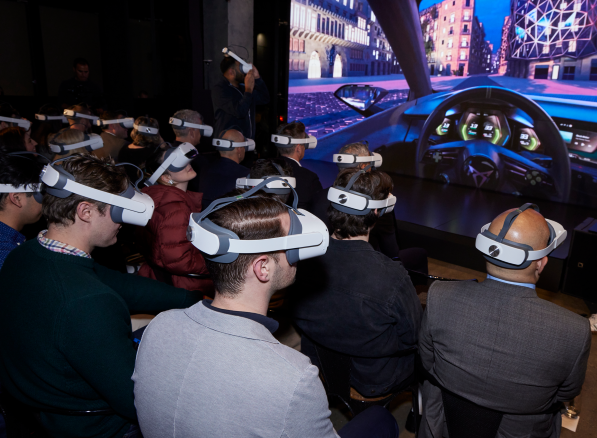VR experiences can be an immersive & wonderful.
Hire Intelligence own and can provide for hire Headsets from Oculus, Meta, HTC, Varjo and Pico.
We can rent these VR (and indeed AR) headsets on a dry-hire basis – leaving the detail of software and how the headsets will be used to our clients, or their event production managers.
However, we always want our clients and end-users to have a fantastic experience with the tech hardware they rent from us….so this blog highlights some of the additional thinking and planning needed for a VR event to go well. People quite often say, I want the end-users to just ‘pop the headset on’ and experience X,Y and Z…..this can be arranged, but it’s not easy. Having great hardware is part of the solution, but to ensure all goes well at an event, there are a number of considerations and questions, which must be answered (and ideally tested) before a detailed quote can be provided, or anyone should consider ‘going live’…
- Content: Is the content that you wish to show in VR ready and tested?
- Is it specifically designed for VR, and indeed for a specific type of VR headset?
- Is the content (or program/app) available in the Oculus Store, or Playstore, or equivalent….so it can be relatively easily downloaded onto each device?
- Or… is it a one-off file which needs to be transferred (more manually) from a computer to each headset?
- Account Login – For the device, and for each app?: Who’s account will be active on each headset? And if using a specific program, who will sign-in to that program?
- Does the developer of the VR material have accounts to use, or does the client have accounts to use?
- Much like a phone or tablet, or a laptop, who’ll be ‘signed in’ to the device?
- Once ‘signed-in’ to the device….will users need to ‘sign-in’ for the app/content…and if so will each end user need to sign in as an individual? Or will there be a generic account for all devices?
- If ‘Hire Intelligence’ is signed in on the device, but then end users want to download additional material, change settings or purchase additional apps…this can be a problem.
- So who’s accounts/ID/Payment will be used for the device? Who’s account/ID/Payment will be used for each app?
- How will the content be experienced? Imagine the event…
- If you wish your end-users to enjoy content which involves any moving around, then each headset will have to be setup in that exact space prior to any use….so a ‘safe zone’ can be marked out.
- If it’s a 360’ film, then will each user start the film at different times (headsets available to be put on, or taken off when users choose)? OR Will a synchronised ‘start’ be needed for all the headsets as a ‘one-off showing’?
- If again we think of the headsets like a phone, tablet or laptop, you can have a great video you want to share with colleagues on your device, but if they pick up your tablet, they then have to do a number of steps to get the video to play – 1. Unlock it 2.Browse to gallery app (or youtube app), 3. find the right video, and then 4. press play. If they stop watching half way through the video, and put the phone down….the next person would pick it up and just see the second half of the video. Headsets are just like these other devices….with similar layout of menus and various apps….but the menu screen is visible through the headset.
- Does the experience need to be ‘on-line’? – if a live event, or virtual meeting then YES. If all content can be loaded onto the headset before the event, then NO. If yes….then the headsets will also need to signed-in locally to the local Wifi…who will do this? When?
- How and where will device batteries be charged?
- Will you provide training on the devices, or Lock the devices down: So to ensure the end -users get the experience you want them to….
- Will someone train the end-users as to how to navigate to (and use) the right content?
- how many trainers would you need for the size of audience),
- Or do you somehow want content locked down (and perhaps headsets fixed in one app, or have content playing on a loop)?
- Will someone train the end-users as to how to navigate to (and use) the right content?
None of the above are insurmountable challenges, but they do need thinking through, and this is one of many reasons we recommend a small trial ahead of a larger event. It’s also a reason to start talking with Hire Intelligence early about your plans for an event, and we can discuss our previous experiences with VR-hire.
Some further notes detailing steps for loading of content onto VR Headsets:
Meta/Oculus Quest devices:
- In mid-2022, we can pair multiple Quest Headset devices with a single mobile phone logged in to a CHOSEN Oculus account, and thus log onto multiple devices with a single CHOSEN Oculus/Meta Account.
- For each Quest before loading content – steps:
- Factory reset from previous rental.
- Pair each headset with the phone & CHOSEN Oculus Account,
- Get them on to local Wifi to make downloading material possible,
- Get through the ‘health and safety’ briefing (watch in headset).
- After this 5-minute briefing, we can then use the headsets freely, and browse the app store, or the internet, or work to upload other content.
- Loading Apps:
- With above steps undertaken (with headset now logged in with CHOSEN account)… we can go to the Oculus Store and downloaded apps which are available in that store.
- As mentioned above – users might still need to be prepared to use their own email/password for some apps.
- Just as with a laptop – Once signed in on the device, you’d still have to sign into your own gmail, or Skype or bank app for anything to work.
- Loading Non-App Content: For example – APK files and 360’ video.
- Once signed in with the CHOSEN Account on the device…..if content is NOT an app, but definitely designed for VR….then we can transfer files from computers into each headset manually (via a link cable).
- Files have to be in the right format and with the right extension. (Often _360, or .apk files).
- Note – some 360’ content is perhaps easiest to ‘see’ on the headset, if the content is just uploaded to YouTube. In the headset we’d then download YouTube as an app, and users can then navigate to the relevant video through that platform…as they would on phone/computer.
Loading of content onto VR Headsets – Android Based – (Non Meta Headsets)
- Similar to the above for the Meta/Oculus Hardware….Again, each headset will need to be reset from any previous jobs. Then paired with a phone with relevant account. Then connected to Wifi…so we can download apps, or transfer VR Ready files via cable. However, the process is swifter, and often the control of multiple devices at once a little easier than it is with current Meta/Oculus headsets.



